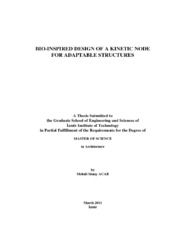Please use this identifier to cite or link to this item:
https://hdl.handle.net/11147/3133Full metadata record
| DC Field | Value | Language |
|---|---|---|
| dc.contributor.advisor | Korkmaz, Koray | - |
| dc.contributor.author | Acar, Melodi Simay | - |
| dc.date.accessioned | 2014-07-22T13:50:56Z | - |
| dc.date.available | 2014-07-22T13:50:56Z | - |
| dc.date.issued | 2011 | - |
| dc.identifier.uri | http://hdl.handle.net/11147/3133 | - |
| dc.description | Thesis (Master)--İzmir Institute Of Technology, Architecture, İzmir, 2011 | en_US |
| dc.description | Includes bibliographical references (leaves: 112-119) | en_US |
| dc.description | Text in English; Abstract: Turkish and English | en_US |
| dc.description | xiii, 119 leaves | en_US |
| dc.description.abstract | The architectural design should no longer consider just in terms of today's demands, but also the life cycle and the further requirements of the built environment. The design process should consider the adaptation to the changing conditions which can be in terms of the building usage, environmental factors or even in the changes ofsociological demands. Rapid change in activities of modern society and building technologies, has led to the need for adaptable spaces. Those spaces can be obtained by the adaptable structures which have potential for using our resources in efficient way and also for responding to the era's needs. This can be achieved with kinetic structural systems and learning adaptable structures from nature.Nature has always inspired humanity by solving the basic needs with minimum material and sustainable solutions. Observation of nature enables architects and engineers familiar with highly developed structures and lead to the creation of new forms. The designs that are produced by learning from nature lead to practical engineering solutions in terms of sustainability. The aim of this research is to propose a joint; kinetic node with multidisciplinary approach. This kinetic node is designed by inspiring from the minimum energy shape configurations and the structural orders in natural structures especially the cell membrane and analyzing the joining details of space truss structural systems and the geometric principles of Bricard linkage mechanism. This new kinetic node gives capability to construct variable static and dynamic structural systems while constructing in different structural orders. | en_US |
| dc.language.iso | en | en_US |
| dc.publisher | Izmir Institute of Technology | en_US |
| dc.rights | info:eu-repo/semantics/openAccess | en_US |
| dc.subject.lcsh | Sustainable architecture--Designs and plans | en |
| dc.subject.lcsh | Sustainable buildings--Designs and plans | en |
| dc.title | Bio-Inspired Design of a Kinetic Node for Adaptable Structures | en_US |
| dc.type | Master Thesis | en_US |
| dc.institutionauthor | Acar, Melodi Simay | - |
| dc.department | Thesis (Master)--İzmir Institute of Technology, Architecture | en_US |
| dc.relation.publicationcategory | Tez | en_US |
| dc.identifier.wosquality | N/A | - |
| dc.identifier.scopusquality | N/A | - |
| item.openairecristype | http://purl.org/coar/resource_type/c_18cf | - |
| item.grantfulltext | open | - |
| item.fulltext | With Fulltext | - |
| item.cerifentitytype | Publications | - |
| item.openairetype | Master Thesis | - |
| item.languageiso639-1 | en | - |
| Appears in Collections: | Master Degree / Yüksek Lisans Tezleri Sürdürülebilir Yeşil Kampüs Koleksiyonu / Sustainable Green Campus Collection | |
Files in This Item:
| File | Description | Size | Format | |
|---|---|---|---|---|
| T000940.pdf | MasterThesis | 10.15 MB | Adobe PDF |  View/Open |
CORE Recommender
Page view(s)
1,576
checked on Jul 7, 2025
Download(s)
752
checked on Jul 7, 2025
Google ScholarTM
Check
Items in GCRIS Repository are protected by copyright, with all rights reserved, unless otherwise indicated.